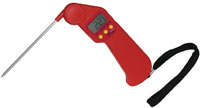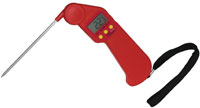Reheat (regenerate)
As discussed throughout our site, sous-vide means bringing the food to the optimal temperature you want it to cook at - never hotter. So when you reheat it to around the same temperature, you don't overcook it and it doesn't dry out. In addition, you can leave the food until you need it, an absolute lifesaver when making multiple courses / dishes.
How do I reheat meat with sous vide?
To heat your meat without cooking, place your vacuum bags with food in water that has been heated to just below the original cooking temperature (approx. 2 degrees lower). Smaller portions take about the same amount of time to heat up as they do to cook. Larger portions don't take the full cooking time to reheat - you've already broken down the muscle and achieved the desired texture. When reheating large roasts, the goal is to heat the meat just long enough to heat up the center.
Want some more precise guidance on reheating that cut of meat you've kept in the fridge after braising? We have some guidelines below. Keep in mind that the size and shape of the meat will determine how long it takes to heat up. And as always: measuring is knowing! If you really want to be sure that the meat has reached the correct core temperature, we recommend using a sousvide thermometer.
A flat steak
Thickness 10 mm: 20 minutes heating time
Thickness 25 mm: 1 hour heated warm-up time
Thickness 50 mm: 3 ½ hour heating time
Thickness 60 mm: 5.5 hours warm-up time
A cylindrical roulade
Thickness 10 mm: 11 minutes heating time
Thickness 25 mm: 40 minutes heating time
Thickness 50 mm: 2 hours heating time
Thickness 60 mm: 2 ½ hours heating time
Thickness 75 mm: 3 hours heating time
Thickness 85 mm: 4 hours heating time
A spherical shape
For example a meatball or a round roast.
Thickness 10 mm: 8 min. Heating time
Thickness 25 mm: 25 min. Heating time
Thickness 50 mm: 1 ½ hour heating time
Thickness 60 mm: 2 hours heating time
Thickness 75 mm: 2 ¾ hour heating time
Thickness 85 mm: 3 ½ hour heating time
Thickness 105 mm: 5 hours heating time
Thickness 115 mm: 6 hours heating time
These are not pasteurization times!
All the above calculations assume that the temperature of the water is between 45 ° C and 80 ° C.
Why regenerate meat at a slightly lower temperature?
Why heat up one or two degrees lower than the original cooking time? Why not heat up at the same temperature? You can fully reheat food at the same temperature you originally cooked it on, especially if you plan to use it right away once it's done. However, after a certain time, the food will start to change. This is much slower than using a traditional method and cooking at a much higher temperature, but if you leave food in hot water long enough, the food will eventually overcook. Warming up to a slightly lower temperature gives you a longer runway, so you can leave your food in the water without worry.
 Buy a good thermometer
Buy a good thermometer
SousvideKenner offers a number of high quality thermometers that are indispensable for the serious sous-vide chef: https://www.sousvidekenner.nl/overig-keuken/thermometers/
ep.rescaleFactor, unit: csStep.unit} "cs-content =" csStep.step.title "ng-if =" csStep.step.title.length> 0 "strip-outer-paragraph =" true "trust-unsanitized = "csStep.createdByAdmin"> Reheating sauces, soups and broths?
Sauces and soups are ideal for heating with sous vide. When heating in the traditional way you always have to make sure that nothing burns or sticks to the bottom, with sousvide you just put the product in a water bath and you don't have to worry about it anymore.
Reheating sous vide is the only way to preserve flavor, texture, and color - three incredibly important qualities of any worthy sauce (or any food for that matter). Like mashed potatoes, divide your sauce into smaller bags and place them in a water bath (usually at about 60 ° C) to heat evenly. If you are in a hurry or have a lot of sauce to heat up, you can knead or shake the bags every few minutes to speed up the process. Try preparing your sauces in advance for your next big dinner. Warm up when you're done, and watch your day of cooking become so much easier.
Pork chops and roasts
The new recommendation for whole pieces of unground pork is 63 ° C, measured with an accurate food thermometer in the thickest part of the meat, after which the meat rests for three minutes before cutting or consuming.
This is an important breakthrough for pork quality. Pork is simply juicier and more tender at the new "safe" temperature of 63 ° C (they are likely to rise to about 65.5 ° C when resting). At that temperature, the pork will be very pale pink. You can make chops even better with about 30 to 60 minutes in a 5% salt solution.
There is good reason to make this change
It was once easy to get the parasite trichinosis from undercooked pork. Today, trichinosis is almost eradicated in developed countries. Trichinosis is caused by eating raw or undercooked pork and some of the game infected with the larvae of a species of the parasitic worm trichinella. The annual average is now less than 40 cases per year in the US, most commonly associated with eating undercooked game such as bears. Pork trichinosis was about five cases per year in 2006, mostly from eating uninspected home-grown pigs. The number of pork cases has declined due to improved farming and processing methods, as well as public awareness of the importance of good cooking. Trichinosis is killed at 59 ° C.
Poultry
The USDA has not changed the recommendations for poultry products, including ground chicken and turkey, that remain at 74 ° C. Salmonella is common in commercial chickens, and is commonly found in organic chickens and free-range chickens, and every technical reference I've ever seen says this temperature weighs quite heavily, with one minor exception, sous vide, which I will discuss below. Poultry white meat, such as "the other white meat", also benefits from a short bath in salt water before cooking.
Red meat
Unfortunately, the USDA still tells us to bake and roast steaks, lamb chops to 63 ° C with a 3-minute rest. This is actually a step back because they added the three minute rest, in which the temperature of the meat will rise. This was not the case with previous recommendations. At 63 ° C, a steak is medium rare, usually brown / gray with a hint of pink. At this temperature it takes more effort to cut through the muscle fibers with your teeth. Many of the juices have solidified and those juices provide the flavor, so the meat is less tasty. When it rests for 3 minutes, it gets close to well done, a terrible waste of good meat.
The optimum temperature for a steak's tenderness, juiciness and flavor is medium rare, about 54.5 to 57 ° C. Most steak aficionados know this and no steakhouse could continue to work alreadys they would follow the 63 ° C plus 3 minutes guideline.
As far as I know there is little risk when eating red meat, as long as one pays attention to hygiene and food safety.
Food Safety
Harmful bacteria such as e-coli can occur on the surface of meat, but do not get far into the meat. For example, when cooking steaks, the temperature of the outside of the meat will be exposed to temperatures above 63 ° C, which will kill harmful bacteria. This makes it a bad idea to use a tenderizing device / gadget or fork, because they push the bacteria to the center of the meat by perforating the outer layer.
Grinded meat
Ground meat, except poultry, must be cooked at 71 ° C and does not require a rest period. This temperature hasn't changed and it means you shouldn't be serving pink burgers especially for children and the elderly. E-coli is not a trivial opponent. It can weaken people, damage kidneys and even kill people.
The problem is that if meat is contaminated in the slaughter process, when it is ground (unlike steaks), the dirty stuff is spread all over. So ground meat just needs to be cooked warmer or longer to kill the bacteria in the middle.
Now I know a lot of you love to eat red or pink burgers, but let me ask you to take a blind taste test the next time you're in a steakhouse. Order two burgers, a medium rare and one at 71C. Put on a blindfold and taste the two. It will be very difficult to tell them apart. That's because the meat is "pre-chewed". It is made super soft by the mill. Unlike well done steaks, well done burgers are not significantly chewier. And since the best burgers aren't made from lean meat, because they contain about 20% fat, even a 71C burger can be deliciously juicy.
But if you really need those weird or pink burgers, sterilize the meat yourself before making it minced: nutrition scientists say that if you dip a piece of steak in boiling water (100 ° C) for 10 seconds before grinding it yourself, it's safe is made. Although the outside turns gray, it grinds well and makes delicious, flavorful weird burgers.
Moral: Cook burgers to 71 ° C unless your meat has been sterilized. Why take the risk? Also do not forget to put on your seat belt and not to smoke in bed. The same.
Organic is no guarantee
If the meat is very fresh and if it has been handled very carefully during slaughter and processing, there may be very few bad bacteria. This is indeed an important factor in food safety. The more critters there are, the longer it takes and / or more heat is needed to kill them all. But there is no way for most of us to know exactly how fresh a steak is and how the carcass was treated. Now I know some of you are going to tell me how safe you feel to eat grilled chicken and their eggs, or a rare burger from the grass-fed organic oxen you bought at the farmer's market, but the fact is that meadow chickens are polluted wandering grass through bird, vole, rabbit and deer droppings, and it can just be risky. Organic meadow chickens can be just as dangerous as factory chickens. Ditto for other fruits and vegetables. Everyone should be informed and careful about food safety, regardless of who their supplier is.
Sous Vide does not play according to standard rules
Heat kills bacteria, but bacteria don't all die at once when the meat hits 63 ° C. They start to scratch at about 54 ° C, and in theory, if you keep a piece of beef at a temperature of 54 ° C for about two hours, you can kill all the bugs.
This is the whole theory behind the latest and most exciting emerging concept in cooking, sous vide. Yes, I know it is not new, but it is new affordable. Sous-vide is French for "under vacuum", so called because the cook puts a steak in a plastic bag, adds spices, maybe a marinade, and sucks all the air out with a vacuum sealer. The bagged meat then becomes a cotton ballbath and kept at 54 ° C for hours until it is an even 54C for two hours, making it completely sterile and amazingly tender, because at that temperature enzymes activate which make the meat extra tender. The problem is that the meat lacks the rich flavor and sharp texture of the Maillard chemical reactions that happen with surface amino acids and sugars when grilling a steak, so sous vide chefs often sear the outside in a pan, under a grill, or on a grill a few minutes before serving.
Sous vide can even be used for burgers and poultry, making it safe at much lower temperatures.
Until recently, sous vide systems were bulky and expensive, only suitable for restaurants, but in the past few years they have gotten smaller and cheaper. View our full collection of sous-vide equipment .
The best way to stay safe: buy a good digital thermometer
 You will also notice that the entire system is based on internal temperatures of meat at its thickest part. Good chefs use a thermometer as their guide, not a clock. A recipe that says "cook at 165 ° C for 2 hours" is a recipe for disaster, because your oven is probably anything but accurate. Even new ovens are often not properly calibrated. There is no substitute for a good digital oven thermometer in combination with a good digital meat thermometer. This is especially true for outdoor chefs. The dial thermometers on most grills, even the expensive ones, are worthless, often sitting at 10 ° C or more in addition to the actual temperature.
You will also notice that the entire system is based on internal temperatures of meat at its thickest part. Good chefs use a thermometer as their guide, not a clock. A recipe that says "cook at 165 ° C for 2 hours" is a recipe for disaster, because your oven is probably anything but accurate. Even new ovens are often not properly calibrated. There is no substitute for a good digital oven thermometer in combination with a good digital meat thermometer. This is especially true for outdoor chefs. The dial thermometers on most grills, even the expensive ones, are worthless, often sitting at 10 ° C or more in addition to the actual temperature.
The internet and many cookbooks tell you that you can tell when a steak is ready by poking it and comparing the resistance to the meat in your hand. THIS IS NONSENSE!!!! Unless you're an experienced pro, you can't tell a steak's doneness by poking it! The resistance of the steak depends on the cut of meat you are poking, the quality of the meat, how thick it is, the age of the ox, the breed of the ox, the age of the meat and what the ox is was fed, among other things. A premium filet mignon feels much more tender than a prime rib. A 3cm thick ribeye feels different than a 1cm thick ribeye.
In addition, the resilience of our hands varies from young to old, from thin to thick, from athlete to couch hanger. OK. It is true that top steakhouse chefs can guess the internal temperature of a steak just by poking it. But they pricked thousands of steaks, all from the same supplier, all the same thickness, all cooked at the same temperature.
The rest of us need a food thermometer
Food is expensive. It is expensive and embarrassing to ruin it. Friends and family are invaluable, it is no fun to make them sick. Doneness and color are controlled by one thing: the temperature of the food. For home cooks, there is simply no substitute for a good digital thermometer.
This is what USDA says, and I wholeheartedly agree: "The color of cooked meat and poultry is not always a sure sign of the degree of doneness. Only by using a food thermometer can one accurately determine whether a meat has reached a safe temperature. Turkey, fresh pork, minced meat or veal may remain pink even after cooking to temperatures of 71 ° C and above. The meat of smoked turkey is always pink. "In addition, smoked meat is often pink due to a chemical reaction with the smoke, rosé-cooked burgers may be brown, and chicken cooked well above the safe temperature may still have bloody stains.



